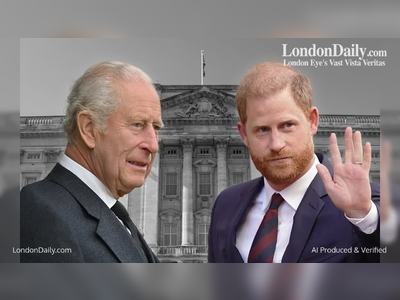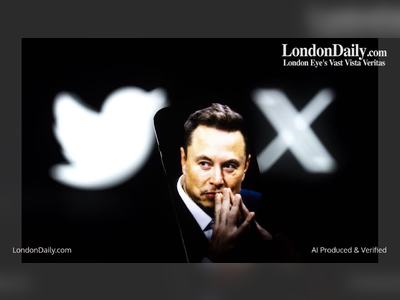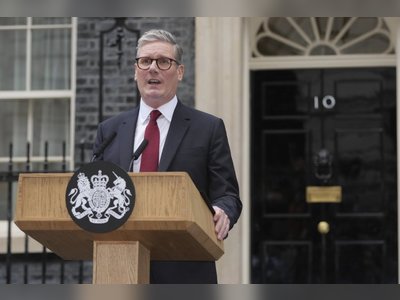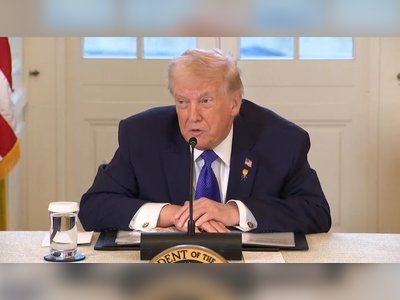
America’s Health Will Soon Be in the Hands of Very Minor Internet Celebrities
To celebrate the holidays, the fitness influencer Cory Boling did mountain climbers in his apartment in a pair of camouflage swim trunks. His twin brother, Calvin, did squats while holding a kitchen stool.
The duo—muscular, cheerful, constantly shirtless—were two of the most eager participants in a holiday-season Instagram campaign run by the Oklahoma City County Health Department with the help of the influencer marketing agency XOMAD. Their posts were #ads, as well as invitations to stay home for Christmas, wear a mask, stop the spread, keep it tight.
For the health department, this was an experiment—a test of whether social-media influencers could reach Oklahoma residents with paid messages, steering them toward behaviors that benefit public health. Now the department has doubled its budget for the real campaign: the one to get Oklahoma residents vaccinated against COVID-19. It is a relatively new and promising approach to vaccination drives, but also one whose effectiveness, and potential downsides, remain unknown.
Americans’ willingness to receive a COVID-19 vaccine has been rising steadily since last fall, but a large proportion—a bit less than one-third of those surveyed, according to the most recent polls—is still hesitant. Lisa Sherman, the president of the Ad Council, describes the task of persuading these holdouts to get their shots as “literally the most significant public-education effort we’ve ever undertaken” (and the Ad Council has undertaken some pretty significant public-education efforts in the past). To make things even harder, public-health communicators no longer have the benefit of public figures such as Elvis Presley, who once gave a lift to a national immunization campaign with a single photograph of a rolled-up sleeve. These days, even our most mass-appeal celebrities are not nearly as appealing. Each of them has done something to annoy some chunk of the population, and I’m even talking about Bruce Springsteen right now, and I’m even talking about Hilary Duff.
Recommended Reading
In a pinch, local governments are turning to influencers. Lots of them. As many influencers as they can get. “More is better,” says Jeff Niederdeppe, a communications professor at Cornell University who studies the effectiveness of public-health campaigns. The “level of exposure to the message makes a huge, huge difference.” The biggest public-health campaign of the 21st century so far will involve all the classic tools—TV and radio spots, flyers, and billboards—but an army of influencers may end up being just as central.
Whether that army will be successful, though, is another question. No offense at all to the boys with the immaculate biceps, but it’s worth asking what might happen when the nation’s health outcomes are put in the hands of the boys with the immaculate biceps.
Influencers look like a simple solution to a common problem for public-health communicators: They need to reach people who don’t want to be reached, but who spend a lot of time on the internet.
Familiar faces can affect health-related behaviors, for better or worse. (Imagine a Millennial who vapes because she saw it on Instagram and who gets an annual mammogram because she read about Angelina Jolie’s double mastectomy.) So a local health department might try to use that influence for highly targeted outreach that fills the gaps in traditional media campaigns. Rob Perry, the CEO of XOMAD, told me that his public-health efforts tend to draw on influencers with fewer than 10,000 followers. “What’s important is that they’re not professional influencers,” he said. “They have jobs. The vast majority have never even been paid for a post before we contact them. They have real connections with their followers, and their content is seen as organic.”
These campaigns are built on good information, because influencers are able to confer with experts on XOMAD’s custom-built forums. But the campaigns are not specifically about information. They’re about personal stories, emotional appeals, and that buzzword, authenticity. The tactic is a borrowed one, taken from anti-vaccine activists and the vaccine-suspicious wellness influencers who have been parroting their talking points on social media for the past decade. Prior to the pandemic, “the phenomenon of anti-vaccine messaging was going through these networked, authentic voices,” says Kate Starbird, a disinformation researcher at the University of Washington. “The rhetoric is, You can’t trust the government; you can’t trust science; you can’t trust the pharmaceutical companies.” If the government’s top-down communications aren’t getting through, why not try doing what the anti-vaxxers do, and go bottom-up?
As far back as 2013, parent groups were floating just this idea, that the anti-vaccine movement’s strategy—its use of personal stories and “authentic” messaging from online influencers—could be weaponized against it. Some public-health researchers have come to similar conclusions, noting that facts alone are often not enough to inspire positive feelings about vaccines. Meanwhile, there is evidence that “social information” encountered on the internet—comments on an online article, for example—can be effective at shifting attitudes and behaviors. Starting with the 2018–19 flu season, Kaiser Permanente put these findings into practice, sponsoring an outreach effort managed by the nonprofit Public Good Projects, specifically targeting Black and Hispanic populations with low immunization rates in several states. In its first year, the company paid more than 100 small-scale influencers to share their personal stories about getting flu shots, tagged #StopFlu. The posts look like any other influencer content: a mom doing yoga, a young couple popping a bottle of champagne, a woman in elegant white pants reclining beneath a mid-century-modern lamp. But they’re paired with text about vaccines: “This year I’m really focusing on my health, and trying to develop healthier habits. One way of doing that is getting myself and my child a flu shot ...”
A peer-reviewed study of the campaign’s effectiveness was released at the end of last year. The results were mixed: Surveys showed that people who lived in targeted areas were not significantly more likely to have gotten their flu shot than those who lived in similar places without a #StopFlu campaign on social media, but the researchers also found that the influencers’ posts might have reached close to 10 million people, while generating roughly 70,000 likes, shares, and comments. That was enough for Kaiser Permanente to reboot the campaign for the two flu seasons that followed.
The Oklahoma campaign has so far been similarly lacking in clear data to support the project. “We don’t have anything in terms of shifting attitudes,” says Molly Fleming, a communications supervisor in Oklahoma City County’s health department, who got the idea to use vaccine influencers from the chamber of commerce, which pays for Instagram posts encouraging tourism in the area. “The metrics we have are more about how many influencers and how many posts and their reach and that kind of thing,” she told me. (For the upcoming campaign, the health department predicts it will reach 2.45 million people across various social platforms, with a focus on 18-to-34-year-olds.)
This makes sense to the extent that the success of many traditional marketing campaigns is measured in anecdotal evidence or in-house data analysis. So far, XOMAD’s influencer campaigns have produced encouraging stories about declining COVID-19 case numbers in Oklahoma City, or informational-app downloads in New Jersey, but that’s not quite scientific. When I asked Niederdeppe what kind of information social scientists and public-health experts would need to determine whether an influencer push on public health had been successful, he sent a bulleted list. First of all, they’d want to know if a campaign reached a large proportion of its target audience—not just whether people had seen it, but whether they could remember it later. Was there evidence that the people who remembered the ads were more likely to say they planned to get vaccinated? Could every other possible explanation for changing attitudes be ruled out? These are things you won’t learn simply by looking at likes and comments, or even countywide vaccination rates. These sorts of campaigns might work, he said, but “there’s not a lot of data there.”
Susan Anderson is a nurse anesthetist and lifestyle influencer who participated in a XOMAD-led campaign to promote mask wearing with the state of New Jersey around the holidays. Now she says she feels a duty to discuss the vaccine with her audience of mostly 25-to-45-year-old women—though she has some misgivings about the idea of a paid campaign on that topic.
It’s one thing for a health-care worker like herself to share videos about the vaccine, she told me, but the idea that influencers with no relevant background would be posting about vaccines makes her nervous. “I don’t want someone who’s a fashion influencer to say, I went and got the vaccine; it was so cool,” she said. “If you’re saying, I’m taking this vaccine, you should be able to explain why it’s safe.”
Talking about vaccines on Instagram has always been fraught. Anti-vaccine sentiments have been particularly contagious among the audiences of what used to be called “mommy bloggers,” through which stories about perceived threats to children tend to spread like wildfire. Early recipients of the COVID-19 vaccine have already been derided on Instagram as “crisis actors” or pawns in various global conspiracies, and anti-vaxxers have coordinated to derail pro-vaccine hashtags by flooding them with their own content. (It was for this reason that the #StopFlu campaign specifically asked influencers to use the term flu shot instead of vaccination.) As Renée DiResta recently argued in The Atlantic, anti-vaxxers have their own digital army, and they see this moment of uncertainty as an opportunity to advance.
Could pro-vaccination influencer campaigns help to diminish that uncertainty? Visually, there isn’t much difference between a post recommending a vaccine and a post recommending that the viewer replace a vaccine with essential oils: Both convey a message about doing what feels right for you and your family. Anti-vaccine sentiment tends to spread quickly on social media, so that similarity could be an asset. (XOMAD’s Perry suggested that pro-vaccine influencers would be well positioned to spot emerging myths and misinformation on Instagram, and report them back to health departments.) But it also raises the possibility that pro- and anti-vaccine sentiments could end up as dueling Instagram trends, selected or dropped by influencers as they pick through aesthetics and consumer goods to bolster their following. In fact, when I emailed the body-building Boling twins to ask if they would participate in Oklahoma City County’s vaccine campaign, they wrote back to say no. “Because of the high controversy of the topic with the vaccine and not knowing the long-lasting effects, since it was created in under a year,” they told me, they would not be willing to post. The vaccine, they added, could hurt their brand.
As for the influencers who do decide to participate in this campaign—the ones who conclude that pro-vaccine messaging would be good for their brand—nobody really knows what effect they’ll have. “Authenticity” is spoken of in reverent tones by marketers, scientists, and entrepreneurs alike in the Instagram era. But what happens when authenticity and authority are treated as competing values? If health agencies start relying on influencers’ personal stories every time they want to get vital information across—if they start swapping in more and more “organic content” in place of dreary top-down messaging—it may end up signaling, for some, that they’ve abandoned the idea of expertise itself, and turned the most significant public-education effort of our time into a battle over which side’s influencers happen to be most charming and savvy.
It’s a tough spot to be in. We could certainly end up regretting these public-health influencer campaigns, though we might regret the alternatives even more. At this point, we need to try every possible method for getting pro-vaccine messaging to the people who need to hear it most. “It’s unfortunate to have to experiment in the moment,” Starbird, at the University of Washington, told me. “But we don’t really have a better option.”
Comments











